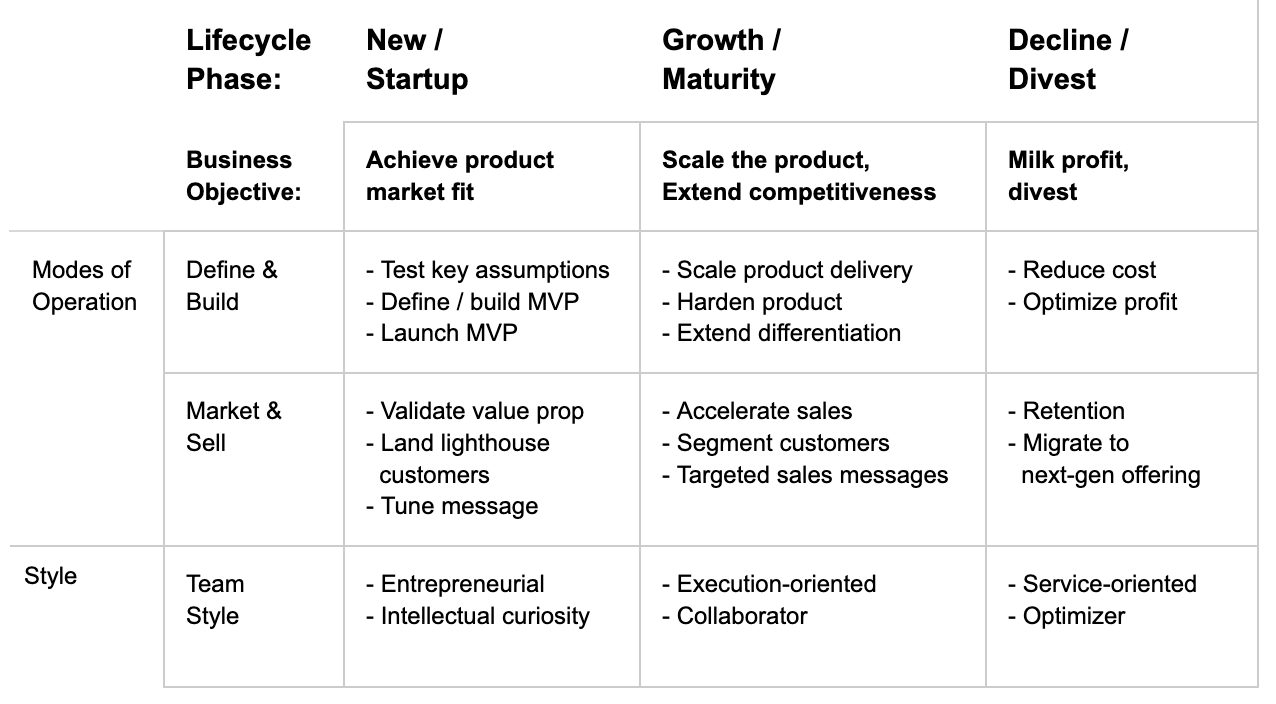Given the essential cross-functional role that product management plays, having an appropriately staffed team is vital and - done well - will have a significant impact on the company’s overall performance.
Building the product team requires more than simply finding product managers with a baseline set of product management skills. The most successful product leaders match the natural style and strengths of their product managers to the state of the product within its lifecycle. The key to building a more effective PM team is to align the mode of operation and the team’s style to the market need.
Mapping the product lifecycle phase to style
The product lifecycle falls into three high-level phases: new products, growth and maturity, and decline. Within each phase, the product management team is focused on two general modes of operation, namely defining and building the product and marketing and selling the product.
The table below describes the high-level business objectives at each lifecycle phase, the goals of the product team within the modes of operation and the general style of the product manager.

What are the product lifecycle phases?
New / Startup
In the case of new products, the start-up phase, the team works to achieve product-market fit whereby the team understands the customers (market) they are going after, the “problem” they intend to solve for those customers and the core value proposition by which the product solves the problem. Not a general value proposition but rather the unique value proposition that causes a prospective customer to buy the product versus a competitive alternative product.
Growth / Maturity
During the Growth phase, the team has achieved product market fit. Meaning, they have validated the customer type, the core problem the product solves and the value proposition unique to the product. At this point, the team switches into scale mode, working to accelerate sales while also deepening the core differentiation.
Additionally, the product team will harden the product - for example, reducing technical debt or neutralizing competitive feature gaps - thereby improving the stability of the product within the market. The growth phase will persist for some length of time but eventually the product reaches a state of maturity within the lifecycle.
Decline / Divest
After a phase of maturity, the product will eventually move into a state of decline within the lifecycle. The state of decline may be due to market forces - e.g. the nature of the core problem ceases to exist. The product may reach a state of decline due to competitive pressures. Regardless of the cause of the decline, revenue starts to decline and the team must embark within the final phase of the lifecycle.
Different product management modes
Irrespective of the state of the product within the lifecycle, product managers function in two primary modes: Define and Build, Market and Sell.
Define and build
The define and build mode is about developing a winning strategy and delivering it through the product. This requires the product manager to obtain a deep understanding of the market, customer needs, and competitive challenges.
Based upon this understanding, the product manager will develop a strategy - considering the market forces - and will work with the extended team to define a product strategy and roadmap to win their intended market. The team will then work dutifully to deliver the product against the prescribed plan.
Market and sell
The define and build mode is about crafting the product strategy and delivering a working version of the product in the context of the intended strategy and intended value prop. In the market and sell mode, the product manager turns his or her attention to increasing sales. There is a vast array of information available about effective sales and marketing strategies, but the simple goal of the product manager in this mode is to help marketing and sales target the correct customer and communicate the benefits and value proposition correctly.
In this mode, the product manager cannot simply “throw the product over the wall and expect sales to sell it”. To be successful, the product manager must work with the marketing and sales teams to drive the necessary growth in sales, through proper incentives, segmentation, communication and more.
Who is the right fit?
Great product managers are deeply focused on the market and the needs of customers but this is a prerequisite set of skills for a product manager. The best product leaders match product managers based on both the skills required as well as the natural style of the product manager.
New / Startup
During the new, introductory phase, the role will require an entrepreneurial product manager (leader), one who possesses a growth mentality and readily adjusts to new data. The entrepreneurial-minded leader is required in the early stages of a new business, searching for product-market fit, adjusting to new data and learning, and ultimately arriving at a successful strategy through an iterative, emergent approach.
The entrepreneurial leader is not fical, he or she will maintain a strong vision of the direction but will remain open to adjusting tactics as new information becomes available. What’s more, this leader maintains a healthy amount of tenacity to go against the grain when he or she is confident in (and has validated) the idea.
Growth / Maturity
Growth follows the start-up stage. At this phase, the product manager has validated product market fit and a path towards growth - and, grow you must. The product manager then switches from validation to scale. An experienced manager is needed to guide the company into a more mature and growth-oriented phase.
This requires a collaborator who can work with all the different stakeholders that are required to make a product successful. This phase also requires extreme focus, someone who knows the direction and will continue to say no to things that take you off track. It also requires a bit of savvy to navigate organizational politics.
Decline / Divest
Finally, as the product enters into a state of decline, the product manager must reduce cost, maximize and extend profit and eventually move consumers to the next generation version of the product. This phase is not glamorous, it is hard work, you need someone who will toe the line and dutifully end-of-life the product. During this phase, “extreme optimizers”, those who obsess over the smallest of details will win the day.
Customer intimacy becomes more important so also look for people who are extremely customer-service oriented, who listen and empathize with customers, and can skillfully retain and migrate customers to the next generation offering.
Conclusion
It's a common complaint from organizations seeking product managers that it's tough to locate top-notch talent. It is even more difficult to match the style to the unique needs of the role but resist the temptation to hire “good enough” talent. This simple framework will help you to match the business and style expertise you need to create a thriving product management team.



 Follow us on LinkedIn
Follow us on LinkedIn



